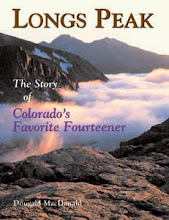Paul Gagner and I skipped out of work (he's the president of Sierra Designs) and did a little dawn patrol yesterday—we headed into the Indian Peaks to explore a route I'd been eyeing for a couple of years. I'd been drawn to the elegant spur that seems to split the east face of Mt. Neva, a 12,814-foot peak on the Continental Divide, as seen in this photo from June 2004 from the trail to Arapaho Pass. When we arrived at the base after a two and a half hour walk, we realized the spur was chossier and less defined than I'd hoped, but the 600-foot face just to its right had a narrow strip of solid golden granite. Although a large cornice sat over the face, we were confident it would fall to the left of our line if it broke off. Anyway, it was still early and cool, and we figured we could climb the line quickly before the morning got too warm. And that's what we did.

 The route went in four long pitches, with moderate rock climbing broken by pleasant scrambling. Neither of us was wearing climbing shoes, so it's tough to grade the difficulty precisely, but the line we followed was probably 5.6 or 5.7. Many of the difficulties could be skirted by deviating into rubble- or snow-filled gullies, but by staying close to the narrow rib that splits the face we found some lovely face and crack climbing. After topping out via a boulder problem just to the right of the cornice, we plodded up a short steep snowfield to Neva's summit, and then descended via the fourth-class north ridge.
The route went in four long pitches, with moderate rock climbing broken by pleasant scrambling. Neither of us was wearing climbing shoes, so it's tough to grade the difficulty precisely, but the line we followed was probably 5.6 or 5.7. Many of the difficulties could be skirted by deviating into rubble- or snow-filled gullies, but by staying close to the narrow rib that splits the face we found some lovely face and crack climbing. After topping out via a boulder problem just to the right of the cornice, we plodded up a short steep snowfield to Neva's summit, and then descended via the fourth-class north ridge.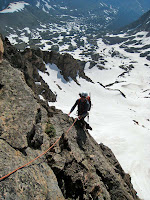 We saw no sign of a prior ascent and I've never read of a route on this face, but it's very unlikely that such a prominent feature would not have been climbed at some point in the popular Indian Peaks. Colorado mountaineers who enjoy moderate alpine-y routes like Sharkstooth or the Spiral Route on Notchtop in Rocky Mountain National Park would love this climb. It's probably at its best in June, when there's still lots of snow around to give it an alpine ambiance and to cover some of the junk left and right of the rib, but it might be a bit safer once that cornice drops off. Either way, this is a climb that deserves attention.
We saw no sign of a prior ascent and I've never read of a route on this face, but it's very unlikely that such a prominent feature would not have been climbed at some point in the popular Indian Peaks. Colorado mountaineers who enjoy moderate alpine-y routes like Sharkstooth or the Spiral Route on Notchtop in Rocky Mountain National Park would love this climb. It's probably at its best in June, when there's still lots of snow around to give it an alpine ambiance and to cover some of the junk left and right of the rib, but it might be a bit safer once that cornice drops off. Either way, this is a climb that deserves attention.
Saturday, June 28, 2008
Hooky on Neva
Posted by
Dougald MacDonald
at
11:42 AM
5
comments
![]()
![]()
Wednesday, June 25, 2008
Fewer Climbers = Bigger Fees on Everest
 This week China announced that it may limit the number of tourists on and around Mt. Everest next year, ostensibly for environmental reasons. "We need to limit the number of people who want to climb Mt. Everest, who exert a negative impact on the environment," Zhang Yongze, the director of Tibet's Bureau of Environmental Protection, said to China's Xinhua news agency. "We will also need to strengthen management of commercial activities involving (the mountain). We don't want so many visitors to disturb the peak."
This week China announced that it may limit the number of tourists on and around Mt. Everest next year, ostensibly for environmental reasons. "We need to limit the number of people who want to climb Mt. Everest, who exert a negative impact on the environment," Zhang Yongze, the director of Tibet's Bureau of Environmental Protection, said to China's Xinhua news agency. "We will also need to strengthen management of commercial activities involving (the mountain). We don't want so many visitors to disturb the peak."
The Chinese said they are planning a major clean-up of the Tibetan side of the peak in the first half of 2009, and indeed visitors have said the Tibetan approach to Everest is trashed. But the Chinese share full responsibility: Last year the government completed a paved road to Everest base camp—hardly a way to limit environmental impact. As laudable as a clean-up would be, a more likely explanation for limiting the number of visitors is continuing concnern about adverse publicty at a time of Tibetan unrest. China closed Tibet to mountaineering completely this spring after protests in Tibetan cities erupted into riots in mid-March. Next year marks the 50th anniversary of the Dalai Lama's flight from Tibet, and Chinese authorities are likely to have Lhasa in a virtual lockdown.
Here's another possible explanation for restricting numbers on Everest: supply and demand. The Chinese may be hoping to raise peak fees again by limiting the number of permits. Currently, peak fees on Everest are much higher on the Nepali side of the mountain, starting at $25,000, with discounts to $10,000 per person for multiple climbers. In Tibet the fee was just $4,900 per person in 2007, the last time the mountain was open. But the fee jumped more than 60 percent that year. If China reopens Everest to mountaineers in 2009, expect smaller numbers to yield much bigger fees.
Posted by
Dougald MacDonald
at
6:21 AM
1 comments
![]()
![]()
Saturday, June 21, 2008
O Say Can You See...
 This spring, while researching a bit about climbing the Grand Teton for the May issue of Men's Journal, I discovered a great reason to climb the Grand again (as if one were really necessary). During an interview with longtime Exum guide Jack Tackle, he mentioned that on very clear mornings, especially in winter but occasionally even in midsummer, you can spot Old Faithful erupting in Yellowstone, about 50 miles away. That is just so cool. Maybe this is common knowledge among Teton guides, but I'd never even thought to look for Old Faithful during any of my trips to the Grand's summit. But I sure will next time. Here's how to spot the geyser: Try to reach the top on a very cold morning with no atmospheric haze, the closer to sunrise the better. Look due north for the 145-foot plume of steam, and be patient: Old Faithful erupts every 45 minutes to two hours, depending on the duration of the previous eruption.
This spring, while researching a bit about climbing the Grand Teton for the May issue of Men's Journal, I discovered a great reason to climb the Grand again (as if one were really necessary). During an interview with longtime Exum guide Jack Tackle, he mentioned that on very clear mornings, especially in winter but occasionally even in midsummer, you can spot Old Faithful erupting in Yellowstone, about 50 miles away. That is just so cool. Maybe this is common knowledge among Teton guides, but I'd never even thought to look for Old Faithful during any of my trips to the Grand's summit. But I sure will next time. Here's how to spot the geyser: Try to reach the top on a very cold morning with no atmospheric haze, the closer to sunrise the better. Look due north for the 145-foot plume of steam, and be patient: Old Faithful erupts every 45 minutes to two hours, depending on the duration of the previous eruption.
Posted by
Dougald MacDonald
at
11:42 AM
1 comments
![]()
![]()
Friday, June 20, 2008
Spearfish = Excellent
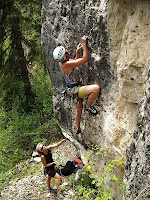 Took a few days off this week to visit Spearfish Canyon on the north side of South Dakota's Black Hills. What a place! This beautiful canyon has around 500 sport climbs on finger-friendly limestone, yet even though we climbed on a weekend in perfect temps we never saw more than two other parties at a crag. The cliffs form in long bands with intermittent sections of good rock, so you have to keep packing up and moving,
Took a few days off this week to visit Spearfish Canyon on the north side of South Dakota's Black Hills. What a place! This beautiful canyon has around 500 sport climbs on finger-friendly limestone, yet even though we climbed on a weekend in perfect temps we never saw more than two other parties at a crag. The cliffs form in long bands with intermittent sections of good rock, so you have to keep packing up and moving, 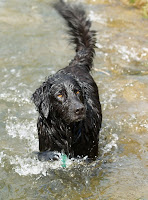 but this was one of the few negatives at an otherwise superb destination, especially for the mid-grade (5.10 to 5.12) sport climber. (The other negatives were a smattering of poison ivy and some drilled pockets on the hardest route we did, making me suspect that other, harder routes might also be manufactured. Oh, and the grades are stiff, so this is no place to boost your ego.) The camping in Spearfish Canyon is pleasant and close by the crags, there were cold creeks for Enzo the wasserhund, and there's a small store and cafe in the center of the climbing.
but this was one of the few negatives at an otherwise superb destination, especially for the mid-grade (5.10 to 5.12) sport climber. (The other negatives were a smattering of poison ivy and some drilled pockets on the hardest route we did, making me suspect that other, harder routes might also be manufactured. Oh, and the grades are stiff, so this is no place to boost your ego.) The camping in Spearfish Canyon is pleasant and close by the crags, there were cold creeks for Enzo the wasserhund, and there's a small store and cafe in the center of the climbing. The Spearfish guidebook is five years old and has only about 60 percent of the routes in the canyon. On our final day, we followed a rumor to a shady cliff called Shadowlands that was not in the guide, and we found the best climbing we'd seen—a band of truly superb limestone with vertical to very overhanging routes and a mix of excellent pockets and Rifle-esque edge and sidepull climbing. If this cliff were a little taller (it averages about 50 feet), it would be famous. As it is, it was empty.
The Spearfish guidebook is five years old and has only about 60 percent of the routes in the canyon. On our final day, we followed a rumor to a shady cliff called Shadowlands that was not in the guide, and we found the best climbing we'd seen—a band of truly superb limestone with vertical to very overhanging routes and a mix of excellent pockets and Rifle-esque edge and sidepull climbing. If this cliff were a little taller (it averages about 50 feet), it would be famous. As it is, it was empty.
Posted by
Dougald MacDonald
at
3:07 PM
0
comments
![]()
![]()
Friday, June 13, 2008
More Vanquished

 I just got these Vanquished photos from Jack Roberts, my climbing partner on Monday. The news that Vanquished is/was in this week has set off a gold rush in Rocky Mountain National Park. A party did the route yesterday on a truly nasty day in the mountains. And untold numbers are going up there today and maybe Saturday, if it survives the warming trend that's on its way. I hope everyone headed up there gets a chance at it. That's the start of pitch two on the left and the fourth pitch, one of the coolest ice pitches in the Park, on the right. OK, I promise I'll stop talking about this climb now.
I just got these Vanquished photos from Jack Roberts, my climbing partner on Monday. The news that Vanquished is/was in this week has set off a gold rush in Rocky Mountain National Park. A party did the route yesterday on a truly nasty day in the mountains. And untold numbers are going up there today and maybe Saturday, if it survives the warming trend that's on its way. I hope everyone headed up there gets a chance at it. That's the start of pitch two on the left and the fourth pitch, one of the coolest ice pitches in the Park, on the right. OK, I promise I'll stop talking about this climb now.
Posted by
Dougald MacDonald
at
7:29 AM
0
comments
![]()
![]()
Thursday, June 12, 2008
Lost
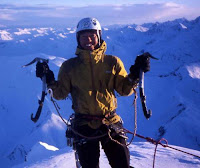 In three years of editing stories for the American Alpine Journal, no one I'd been working with had died in the mountains. That's remarkable, given the difficult and dangerous routes many of these authors attempt. But last month this happy streak ended. I had been working this spring with Tatsuro Yamada from Japan on a feature article for the AAJ about the three new routes he and two companions completed in the Ruth Gorge last year. We had mostly finished the story when Tatsuro went back to Alaska in April. I expected him to return in about a month, and in early May I emailed some questions about the story to him. When there was no reply, I assumed he was still in the mountains. But before long news stories about two lost climbers on Denali began to appear; when we learned they were from Japan, I feared the worst. And indeed Tatsuro had disappeared with his climbing partner, Yuto Inoue, on or above the upper Cassin Ridge. Their bodies or gear have not been found.
In three years of editing stories for the American Alpine Journal, no one I'd been working with had died in the mountains. That's remarkable, given the difficult and dangerous routes many of these authors attempt. But last month this happy streak ended. I had been working this spring with Tatsuro Yamada from Japan on a feature article for the AAJ about the three new routes he and two companions completed in the Ruth Gorge last year. We had mostly finished the story when Tatsuro went back to Alaska in April. I expected him to return in about a month, and in early May I emailed some questions about the story to him. When there was no reply, I assumed he was still in the mountains. But before long news stories about two lost climbers on Denali began to appear; when we learned they were from Japan, I feared the worst. And indeed Tatsuro had disappeared with his climbing partner, Yuto Inoue, on or above the upper Cassin Ridge. Their bodies or gear have not been found.
I never met Tatsuro in person, but he was a joy to work with. He was young—27—and you could tell even though his emails that he was passionate about climbing. He was funny, enthusiastic, and yet extremely humble about his accomplishments. He repeatedly expressed how lucky he was to be climbing these huge new routes in Alaska, especially with some of Japan's finest climbers. And he was not ignorant of the dangers. In his AAJ story, he writes of meeting Jed Brown, who had come to the Japanese camp on the Ruth Glacier for help after Lara Kellogg fell to her death on Mt. Wake. All that night, Tatsuro lay awake thinking about the accident. He writes: "To carry on in my climbing life, I need to find a meaning for death in mountains. It’s a part of climbing, also a part of life. After pondering this throughout the night, I felt more confident, inspired by Lara Kellogg’s soul, which had never stopped climbing until the end." Now the same can be said of Tatsuro's soul.
[Tatsuro Yamada's article about the Ruth Gorge is now completed, and it's available to AAC members who log in at the AAC website; others will have to wait until the 2008 AAJ is published in August.] Tatsuro and Yuto disappeared near the end of a remarkable enchainment of the West and East Kahiltna peaks, straight into the Cassin Ridge on Denali's south face, as seen in this Gerry Roach photo. It's an elegant link-up, and I wonder how history will remember it. It's said that the summit is only halfway, and many people believe an ascent doesn't "count" if the climbers don't make it back. Yet there are many examples to the contrary in climbing history. I just wrote yesterday about the second ascent of the Norwegian Buttress on Great Trango Tower in Pakistan; both climbers who made the summit died during the descent, but they are still remembered for doing the first ascent. In Tatsuro and Yuto's case, however, it's not yet known if they finished the Cassin Ridge and thus completed their planned link-up. Their fate may never be discovered, but if someday evidence is found that they did reach the summit of Denali before dying, I hope they are given full credit for envisioning—and completing—their extraordinary enchainment.
Tatsuro and Yuto disappeared near the end of a remarkable enchainment of the West and East Kahiltna peaks, straight into the Cassin Ridge on Denali's south face, as seen in this Gerry Roach photo. It's an elegant link-up, and I wonder how history will remember it. It's said that the summit is only halfway, and many people believe an ascent doesn't "count" if the climbers don't make it back. Yet there are many examples to the contrary in climbing history. I just wrote yesterday about the second ascent of the Norwegian Buttress on Great Trango Tower in Pakistan; both climbers who made the summit died during the descent, but they are still remembered for doing the first ascent. In Tatsuro and Yuto's case, however, it's not yet known if they finished the Cassin Ridge and thus completed their planned link-up. Their fate may never be discovered, but if someday evidence is found that they did reach the summit of Denali before dying, I hope they are given full credit for envisioning—and completing—their extraordinary enchainment.
Posted by
Dougald MacDonald
at
9:19 AM
1 comments
![]()
![]()
Wednesday, June 11, 2008
Why Do We Have to Get Up So Early?
 Alpine starts are always painful, and this Monday was no exception. The trailhead for the ephemeral Colorado ice climb Vanquished is an hour and a half from my house, and the walk to the route takes about three and a half hours. Since we wanted to arrive at the base shortly after sunrise, I had to set the alarm for 1 a.m. That's just sick. But walking into the mountains in the dark is strangely pleasurable. The woods are full of muffled noises, and approaches seem to pass quicker when you can't see your destination in the distance. And then there are the sunrises, which are often stunning. Here's the east face of Taylor Peak lit up by the morning rays. Surely views like this make the early starts all worthwhile.
Alpine starts are always painful, and this Monday was no exception. The trailhead for the ephemeral Colorado ice climb Vanquished is an hour and a half from my house, and the walk to the route takes about three and a half hours. Since we wanted to arrive at the base shortly after sunrise, I had to set the alarm for 1 a.m. That's just sick. But walking into the mountains in the dark is strangely pleasurable. The woods are full of muffled noises, and approaches seem to pass quicker when you can't see your destination in the distance. And then there are the sunrises, which are often stunning. Here's the east face of Taylor Peak lit up by the morning rays. Surely views like this make the early starts all worthwhile.
OK, that's the prettied-up, magazine-copy version of alpine starts. In truth, views like this make alpine starts somewhat worthwhile. Two mornings later, I'm still exhausted. And, yes, it was beautiful, but at that moment I was mostly just feeling tired from the hours of uphill hiking we'd done with heavy packs, and I was worried about the climb ahead, and my bowels were rumbling 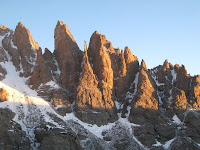 but I was too cold to do much about it. It was blowing so hard that my bare hands were freezing and I couldn't hold the camera still. I snapped a quick shot and stuffed the camera back into my pocket and my numb fingers back into my gloves, wishing the damn sun would hurry higher into the sky, but knowing that we wouldn't feel its warmth for another half a day on the cold north face we were about to climb.
but I was too cold to do much about it. It was blowing so hard that my bare hands were freezing and I couldn't hold the camera still. I snapped a quick shot and stuffed the camera back into my pocket and my numb fingers back into my gloves, wishing the damn sun would hurry higher into the sky, but knowing that we wouldn't feel its warmth for another half a day on the cold north face we were about to climb.
Posted by
Dougald MacDonald
at
7:32 AM
0
comments
![]()
![]()
Tuesday, June 10, 2008
Vanquished, At Last
 Vanquished is one of those routes that every dedicated alpine climber in Colorado would love to do, but almost none has. Yesterday, thanks to a tip from Kelly Cordes, who had completed Vanquished two days earlier with Steve Su, I got to do the climb myself—or at least most of it.
Vanquished is one of those routes that every dedicated alpine climber in Colorado would love to do, but almost none has. Yesterday, thanks to a tip from Kelly Cordes, who had completed Vanquished two days earlier with Steve Su, I got to do the climb myself—or at least most of it.
Each spring, after a cold and wet spell, the whispers go around: "What do you think? Is Vanquished in?" I can't tell you how many times friends have walked in to Powell Peak thinking those white streaks might be ice, only to find they were powder snow over blank granite slabs. The trick is waiting long enough for the snow to melt and refreeze: Vanquished comes into good nick during those rare late May or early June cold fronts that dump lots of moisture and bring numerous freezing nights to the high peaks.
Yesterday it certainly was cold. After the four-mile walk to Sky Pond, Jack Roberts and I nearly bailed because the wind was howling and it was somewhere in the 20s. In mid-June. During the climb, we wore five layers on top, nearly full winter armor, and still we shivered. But of course this is what it takes to bring Vanquished into shape. The key to the route is usually a thinly iced slab on the first pitch. Kelly had said this was the crux of his climb, and he sent me a photo with a possible alternative start. Even though there appeared to be more ice on the normal first pitch than Kelly had found, Jack and I were intrigued with the alternative, which looked difficult and wild. I started up the pitch and then bailed after the first third, scared off by unprotected moves over super-thin foamy ice. (If this pitch were at Loch Vale, 45 minutes from the road, it would be classic, but three and a half hours from the road it seems a lot more serious.) Jack managed to lead through and then carry on up strenuous liebacking and chimneying and a weird and insecure upper groove. It's hard to put a grade on this wild pitch because it wasn't as technically difficult as some things I've done, but it was very insecure and strenuous (especially placing the gear). Jack said it was like an awkward 5.9 crack that keeps coming at you. That sounds right to me. It's possible (but who knows) that this could be in shape more often than the usual first pitch of Vanquished, making that route more doable.
The key to the route is usually a thinly iced slab on the first pitch. Kelly had said this was the crux of his climb, and he sent me a photo with a possible alternative start. Even though there appeared to be more ice on the normal first pitch than Kelly had found, Jack and I were intrigued with the alternative, which looked difficult and wild. I started up the pitch and then bailed after the first third, scared off by unprotected moves over super-thin foamy ice. (If this pitch were at Loch Vale, 45 minutes from the road, it would be classic, but three and a half hours from the road it seems a lot more serious.) Jack managed to lead through and then carry on up strenuous liebacking and chimneying and a weird and insecure upper groove. It's hard to put a grade on this wild pitch because it wasn't as technically difficult as some things I've done, but it was very insecure and strenuous (especially placing the gear). Jack said it was like an awkward 5.9 crack that keeps coming at you. That sounds right to me. It's possible (but who knows) that this could be in shape more often than the usual first pitch of Vanquished, making that route more doable. Above this the climbing was simply superb and very unusual for Colorado. Thin streaks of neve and ice wove through granite ribs and up short chimneys. It felt very much like the Alpine climbing above Chamonix, and not at all like Rocky Mountain National Park's usual snowed-up-rock grovelfests. But the Park returned with a vengeance at the top of the fourth pitch, where I started up a short bulge of ice barring the entrance to the lower-angle groove that leads to the top. Either the sun had hit the ice too much or Kelly and Steve had shattered it, but I soon discovered that the ice wasn't as solid as it looked. With my feet skittering on foam-ice and blank rock, I got high enough on the bulge to plant a tool well over the lip, into what I assumed would be nice neve in the groove. But then all the ice at the lip shattered around and below my pick. Luckily my lower tool was good, and together with a bunch of falling ice blocks I slithered back down to a stance. I tried a bunch of ways to get past this section, including aiding off a pathetic screw, but I couldn't reach any solid ice or higher pro. I brought Jack up, and we decided it just wasn't safe to continue, so we bailed from there.
Above this the climbing was simply superb and very unusual for Colorado. Thin streaks of neve and ice wove through granite ribs and up short chimneys. It felt very much like the Alpine climbing above Chamonix, and not at all like Rocky Mountain National Park's usual snowed-up-rock grovelfests. But the Park returned with a vengeance at the top of the fourth pitch, where I started up a short bulge of ice barring the entrance to the lower-angle groove that leads to the top. Either the sun had hit the ice too much or Kelly and Steve had shattered it, but I soon discovered that the ice wasn't as solid as it looked. With my feet skittering on foam-ice and blank rock, I got high enough on the bulge to plant a tool well over the lip, into what I assumed would be nice neve in the groove. But then all the ice at the lip shattered around and below my pick. Luckily my lower tool was good, and together with a bunch of falling ice blocks I slithered back down to a stance. I tried a bunch of ways to get past this section, including aiding off a pathetic screw, but I couldn't reach any solid ice or higher pro. I brought Jack up, and we decided it just wasn't safe to continue, so we bailed from there.
Vanquished may hang in there for a day or two, but it's over 90 near Boulder today, so probably not. I feel really fortunate to have been able to climb this route, even though we didn't get to finish the last half-pitch, and I'm grateful to Kelly for the tip-off.
Posted by
Dougald MacDonald
at
12:58 PM
2
comments
![]()
![]()




